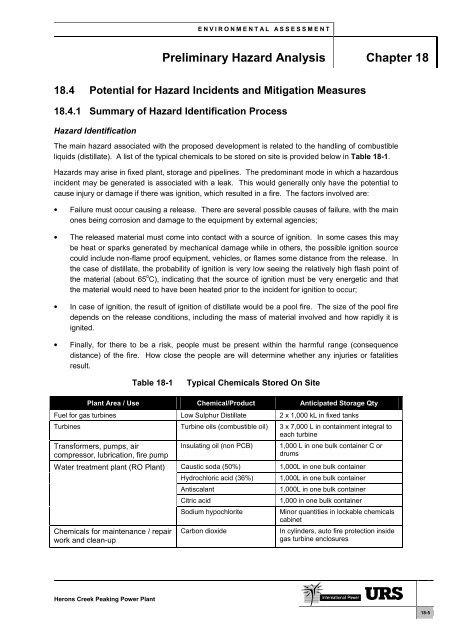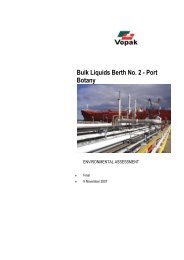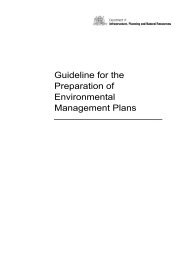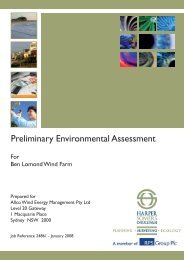Preliminary Hazard Analysis - Department of Planning
Preliminary Hazard Analysis - Department of Planning
Preliminary Hazard Analysis - Department of Planning
You also want an ePaper? Increase the reach of your titles
YUMPU automatically turns print PDFs into web optimized ePapers that Google loves.
E N V I R O N M E N T A L A S S E S S M E N T<br />
<strong>Preliminary</strong> <strong>Hazard</strong> <strong>Analysis</strong> Chapter 18<br />
18.4 Potential for <strong>Hazard</strong> Incidents and Mitigation Measures<br />
18.4.1 Summary <strong>of</strong> <strong>Hazard</strong> Identification Process<br />
<strong>Hazard</strong> Identification<br />
The main hazard associated with the proposed development is related to the handling <strong>of</strong> combustible<br />
liquids (distillate). A list <strong>of</strong> the typical chemicals to be stored on site is provided below in Table 18-1.<br />
<strong>Hazard</strong>s may arise in fixed plant, storage and pipelines. The predominant mode in which a hazardous<br />
incident may be generated is associated with a leak. This would generally only have the potential to<br />
cause injury or damage if there was ignition, which resulted in a fire. The factors involved are:<br />
• Failure must occur causing a release. There are several possible causes <strong>of</strong> failure, with the main<br />
ones being corrosion and damage to the equipment by external agencies;<br />
• The released material must come into contact with a source <strong>of</strong> ignition. In some cases this may<br />
be heat or sparks generated by mechanical damage while in others, the possible ignition source<br />
could include non-flame pro<strong>of</strong> equipment, vehicles, or flames some distance from the release. In<br />
the case <strong>of</strong> distillate, the probability <strong>of</strong> ignition is very low seeing the relatively high flash point <strong>of</strong><br />
the material (about 65 o C), indicating that the source <strong>of</strong> ignition must be very energetic and that<br />
the material would need to have been heated prior to the incident for ignition to occur;<br />
• In case <strong>of</strong> ignition, the result <strong>of</strong> ignition <strong>of</strong> distillate would be a pool fire. The size <strong>of</strong> the pool fire<br />
depends on the release conditions, including the mass <strong>of</strong> material involved and how rapidly it is<br />
ignited.<br />
• Finally, for there to be a risk, people must be present within the harmful range (consequence<br />
distance) <strong>of</strong> the fire. How close the people are will determine whether any injuries or fatalities<br />
result.<br />
Table 18-1<br />
Typical Chemicals Stored On Site<br />
Plant Area / Use Chemical/Product Anticipated Storage Qty<br />
Fuel for gas turbines Low Sulphur Distillate 2 x 1,000 kL in fixed tanks<br />
Turbines Turbine oils (combustible oil) 3 x 7,000 L in containment integral to<br />
each turbine<br />
Transformers, pumps, air<br />
compressor, lubrication, fire pump<br />
Water treatment plant (RO Plant)<br />
Chemicals for maintenance / repair<br />
work and clean-up<br />
Insulating oil (non PCB)<br />
Caustic soda (50%)<br />
Hydrochloric acid (36%)<br />
Antiscalant<br />
Citric acid<br />
Sodium hypochlorite<br />
Carbon dioxide<br />
1,000 L in one bulk container C or<br />
drums<br />
1,000L in one bulk container<br />
1,000L in one bulk container<br />
1,000L in one bulk container<br />
1,000 in one bulk container<br />
Minor quantities in lockable chemicals<br />
cabinet<br />
In cylinders, auto fire protection inside<br />
gas turbine enclosures<br />
Herons Creek Peaking Power Plant<br />
18-5
















